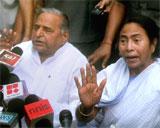
New Delhi, June 14: No Prime Minister has ever gone on to become the President of the Indian Republic. But the record may have to be rewritten, and the country may also have a new Prime Minister, if the Congress’ two powerful partners in the ruling United Progressive Alliance (UPA) have their way.
Dropping a bombshell, Trinamool Congress supremo Mamata Banerjee and Samajwadi Party patriarch Mulayam Singh Yadav on Wednesday jointly proposed Prime Minister Manmohan Singh’s name as the ruling alliance’s nominee for candidature for the July 19 presidential election.
Their joint proposal, made in the national capital in the evening, came after a brief meeting between them that in turn followed Mamata’s separate meeting with UPA chairperson and Congress chief Sonia Gandhi. Singh’s was not the only name they proposed as possible candidates. But the two other names the Mamata-Mulayam duo tossed up – former president A P J Abdul Kalam and former Lok Sabha speaker Somnath Chatterjee – may not find favour with the Congress. Kalam will certainly not be acceptable to the Congress.
“We discussed three names ... A P J Abdul Kalam, Manmohan Singh and Somnath Chatterjee,” Mulayam told newsmen in Mamata’s presence, bringing the Prime Minister’s name in the reckoning for the first time. Before the two leaders went back into another huddle, Mamata, also the West Bengal chief minister, added: “We decided the names based on the persons who are honest, know the Constitution and can work for the nation. It will be good to have a President elected unanimously by all political parties.”
It wasn’t immediately clear if the two powerful allies of the Congress were acting as troubleshooters for the Congress leadership, and if the dramatic proposal was part of any thinking in the ruling political establishment to use the Presidential election to also bring about a change in the leadership of the UPA government.
As such, the UPA leadership has been criticised for creating a situation of “policy paralysis” in the country. The image of Singh has taken a beating in the facing of a mounting economic crisis. The Mamata-Mulayam proposal could also be an oblique hint of a lack of confidence in Singh’s leadership of the government.
Earlier during the day, just a few hours before proposing Singh’s name for Rashtrapati Bhavan, Mamata met Sonia for consultations on the Presidential election. Emerging from that meeting, Mamata told mediapersons that Union Finance Minister Pranab Mukherjee was the Congress’s first choice for Rashtrapati Bhavan, and the second choice being that of incumbent Vice President Hamid Ansari.
Adding to the intriguing proposal, there were strong suggestions within the ruling establishment that the UPA’s presidential nominee would be announced only after Prime Minister Singh returns home from his visit to Mexico and Brazil on the night of June 23. There is time till June 30 to file the nomination papers for the July 19 election. Singh leaves for Mexico on Saturday, the day the Election Commission is scheduled to issue the formal notification calling for the election.
The Congress did not react immediately to the Singh-as-President proposal of the Mamata-Mulayam duo. But the leading UPA partner cannot take the proposal lightly. Between them, the Trinamool Congress and the Samajwadi party command 10.6 per cent of the votes in the Electoral Colleague that elects the President.





Comments
Add new comment